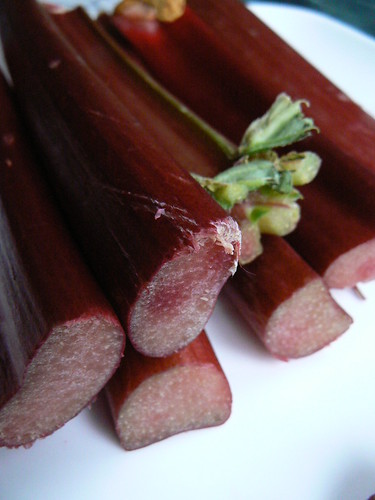Rhubarb and Beyond
I admit: I was always a bit skeptical about rhubarb. The stalks look like nothing more than overgrown Swiss chard stalks, and when cooked I was never overwhelmed by the flavour OR texture. It always seemed more of a kind of a filler for strawberry baked goods than an entity of its own.
But three weeks ago, I found rhubarb at the West End Farmer’s Market that was so plump, red and thick that I overcame my prejudices and got 4 stalks, along with a basket of strawberries, all from the same farmers. I looked up a few recipes but it wasn’t until the morning of the following Saturday that I actually did anything with them (summer berry & rhurabr crumble, recipe will appear here soon).
When I set to slice the ruby-coloured stalks, I expected nothing besides a 2 minute long kitchen chore. Nothing could have prepared me for what I was about to experience. As the knife’s blade cut through those stems, a fragrance was released – so peculiar, and strange yet appealing – that my jaw dropped right to the kitchen floor. It smelled like crisp grass, unripe berries or fruit and ozone. The latter element is what makes it every so slightly repulsive and ever so much more interesting and not at all like its earthly Swiss chard friends.
I baked my crumble, and although I enjoyed it quite a bit, there was very little of the fresh rhubarb aroma left after the baking. So I thought – why not leave rhubarb in the raw and eat it this way?
My research for raw rhubarb recipes did not lead to much, except for a little vague recipe for a “fresh rhubarb compote” that the author had at Rendevouz.
One word of caution about rhubarb in general though, is that you must remove all leafy parts, as these are toxic (regardless of cooked or raw). The stalks are not toxic when raw, but most people do not appreciate the distinctive flavour and aroma of this peculiar vegetable and add plenty of sugar and cook it to death. I think that raw rhubarb feels like eating a modern perfume, only better because there are no synthetics involved.
Below is how I made it, two days ago. It finally was ready today and I had it for desserts and enjoyed every crispy, crunchy bite of the fragrant and tart rhubarb. And another good part is the bejeweled appearance of this salad - with ruby-like cranberries and citrine slices of apricot.
First of all, be sure to select the freshest, most plump and brightly red rhubarb stalks for this recipe. This is important for both the flavour and the texture, as this rhubarb will not be undergoing any cooking whatsoever. The following recipe will make 4 people curiously satisfied.
2 Fresh Rhubarb Stalks, thinly slices
6 Dried Apricots, sliced
2 Tbs. Dried Cranberries
2 Tbs. Honey
2 Tbs. Cointreau or Grand Marnier liquor
1 Tbs. Gin
1 tsp. fresh rosemary leaves
Rinse the stalks and scrape any unsightly browned bruises they may have.
Slice very thinly.
Add cranberries, sliced dried apricots, the honey and liquors. Sprinkle rosemary leaves all over the rhubarb and fruit. Seal in an airtight container and marinate in the fridge for 2 days. Be sure to shake and container twice a day for the flavours and juices to thoroughly flavour the entire salad.
Serve chilled, on its own or with a dollop of Crème Fraiche on the top.



